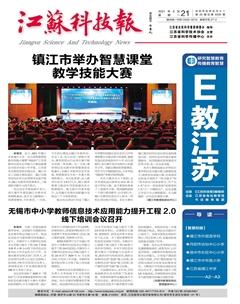Driving K-12 Innovation: 2021 TECH ENABLERS(Ⅰ)
Product by CoSN (Consortium for School Networking)? ?美國學校網絡聯合會
《基礎教育創新驅動力報告》是繼《地平線報告(基礎教育版)》后推出的國際教育信息化發展的重要參考報告,報告發布方美國學校網絡聯合會(CoSN)為《地平線報告》發布方美國新媒體聯盟的原有合作伙伴,致力于為基礎教育及學前領域的教育技術從業者提供團隊、知識和專業發展服務,助力創建和發展更有吸引力的學習環境。
Introduction
CoSNs Driving K-12 Innovation initiative convenes an international Advisory Board of 100+ education and technology experts to select the most important topics impacting teaching, learning, and education innovation around the globe. The first step is an initial survey to select Hurdles (barriers), Accelerators (mega-trends), and Tech Enablers (tools) for discussion. The Advisory Board then responds to prompts and discusses the topics via a virtual online forum and synchronous video calls. Finally, the Advisory Board completes a survey to select the top Hurdles, Accelerators, and Tech Enablers.
Each year, themes arise from the Advisory Boards work and this year in particular, the interconnectedness of specific Hurdles, Accelerators, and Tech Enablers quickly became a major point of conversation. Inspired by this, the editorial team expanded the Driving K-12 Innovation framework to explicitly call out Bridges. Bridges (themes) are recommendations, considerations, and mindsets to drive K-12 innovation that span our three lenses of Hurdles, Accelerators, and Tech Enablers. These overarching themes from Advisory Board discussion speak to important synergies and intersections between topics. Bridges emerge from Advisory Board discussion and are not voted on in the final survey.
This publication focuses on the Top 3 Tech Enablers for 2021 and one key bridge: Systems Thinking.
The COVID-19 Pandemic + Driving K-12 Innovation
The Driving K-12 Innovation framework helps us make sense of the state of the world and chart paths forward. The COVID-19 pandemic is one such state of the world, a critical component of the context in which students, educators, and families create learning experiences and re-imagine the future of education. The Advisory Board discussed many ways in which the current state of the world is impacting Tech Enablers and the way we use them.
Top 3 Tech Enablers
1.Digital Collaboration Environments
Digital systems, tools, technologies, connectivity, and pedagogy that enable high levels of collaboration and support online and in person learning. Digital Collaboration Environments include both synchronous and asynchronous communication tools—platforms that allow multi-user, virtual communications, whether across the room or across the globe.
2.Untethered Broadband and Connectivity
Ubiquitous broadband Internet and the underlying technologies that enable robust connected learning—without requiring devices to be physically connected (via cables, for example). These technologies enable mobility and learning anytime, anywhere.
3.Blended Learning Tools
Digital tools, technologies, and pedagogy that enable learning experiences through a mix of face-to-face and online interactions. These tools can be used to strategically integrate online and in-person activities to enhance student learning.
Key Bridge: Systems Thinking
The fundamental design of the system is the biggest hurdle of all—from what is meant by "a school", to the structures and assumptions that define the learner experience, the technologies we choose to support and enhance teaching and learning, and even the teaching profession itself. The pandemic has required schools to quickly adapt, and in so doing, we're reminded that assumptions and traditions are more flexible than we thought.
The theme of Systems Thinking shares elements of Hurdles (for example, Lack of Systemic Perspectives), Accelerators (like Design Thinking) and Tech Enablers (including Digital Collaboration Environments).
In order to transform education and to adapt/innovate successfully we must acknowledge the systemic nature of education and be willing to rethink the design of these systems. Doing so will help us overcome barriers of and within systems, and take advantage of opportunities presented by setting aside assumptions and rethinking systems. Intertwined in this are the tools and practices used to construct, reinforce, disrupt, or reinvent systems.
In grappling with this moment in time, the Advisory Board repeatedly organized, re-structured, dismantled, and connected Hurdles, Accelerators, and Tech Enablers. Together, we kept returning to the imperative of leveraging systems and design thinking to build learning futures for student and community success.
譯文
概述
美國學校網絡聯合會的《基礎教育創新驅動力報告》召集了一個由100多名教育專家和技術專家組成的國際咨詢委員會,以選擇影響全球教學、學習和教育創新的最關鍵的主題。第一步是初步調查,選擇挑戰(障礙)、加速器(大趨勢)和技術驅動因素(工具)進行討論。咨詢委員會隨后對初步調查的諸多主題給予反饋,并通過虛擬在線論壇和視頻電話同步討論這些主題。最后,咨詢委員會完成了這項調查,選擇出最重要的挑戰、趨勢和技術驅動因素。
每年主題都來源于咨詢委員會的評選,但今年比較特殊,特定挑戰、趨勢和技術驅動因素之間的相互聯系迅速成為主要的對話點。受此啟發,編輯團隊擴展了《基礎教育創新驅動力報告》的框架,以明確調用這些具有聯結作用的橋梁。橋梁(主題)包括推動基礎教育創新的建議、因素和思維方式,跨越了我們的三個研究視角:挑戰、趨勢和技術驅動。咨詢委員會討論的這些首要主題說明了主題間有重要協同作用和交叉點。咨詢委員會也討論了起關鍵聯結作用的橋梁,但沒有在最終調查中投票。
本報告重點介紹2021年的三大技術驅動因素和一個關鍵橋梁:系統思維。
新冠肺炎疫情大流行與《基礎教育創新驅動力報告》
《基礎教育創新驅動力報告》框架幫助我們了解世界狀況并規劃前進的道路。新冠肺炎疫情全球大流行是目前世界的一種狀態,是學生、教育工作者和家庭創造學習體驗、重新構想教育未來環境的重要組成部分。咨詢委員會討論了當前世界狀況影響技術驅動因素的多種方法以及我們使用它們的方式。
三大技術驅動因素
1.數字協作環境
數字系統、工具、技術、連接性和教學法,能夠促使高水平協作的實現并支持在線和面對面學習。數字協作環境包括同步和異步通信工具——不管是跨區域還是跨全球,允許多用戶、虛擬通信的平臺。
2.無限制的寬帶和連接
無處不在的寬帶互聯網和底層技術支持強大的互聯學習——無需物理連接設備(例如通過電纜連接)。這些技術支持隨時隨地的移動學習。
3.混合學習工具
數字工具、技術和教學法,提供了一種面對面和在線互動教學相結合的學習體驗。這些工具可用于戰略性地整合在線和面對面的教學活動,以加強學生的學習。
關鍵橋梁:系統思維
系統的基本設計是最大的障礙——從“學校”的含義到定義學習者體驗的結構和設想,我們選擇支持和加強教學和學習的技術,甚至是教學專業性本身。新冠肺炎疫情暴發要求學校能迅速適應,在這樣做的過程中,我們意識到假設和傳統比我們想象的更靈活。
系統思維的主題共享了挑戰篇(例如缺乏系統觀點)、趨勢篇(如設計思維)和技術驅動篇(包括數字協作環境)的各種元素。
為了轉變教育并成功地適應或創新,我們必須承認教育的系統性,并愿意重新思考這些系統的設計。這樣做將幫助我們克服系統和系統內部的障礙,并利用擱置假設,重新思考系統所帶來的機會。其中,用于構建、強化、破壞或重新發明系統的工具和實踐將會交織在一起。
為了及時應對這一時刻,咨詢委員會反復組織、重構、拆除并聯結挑戰、趨勢和技術驅動因素。如今,我們一起努力,不斷重新認識利用系統和設計思維的必要性,來為學生和社區構建一個成功的未來學習環境。

